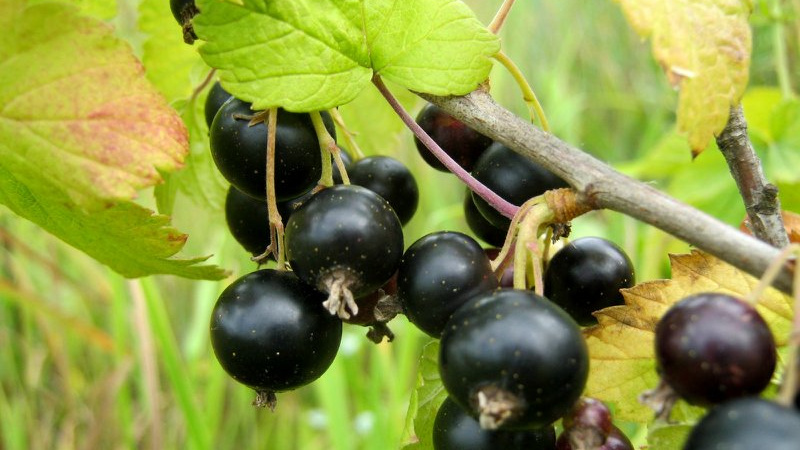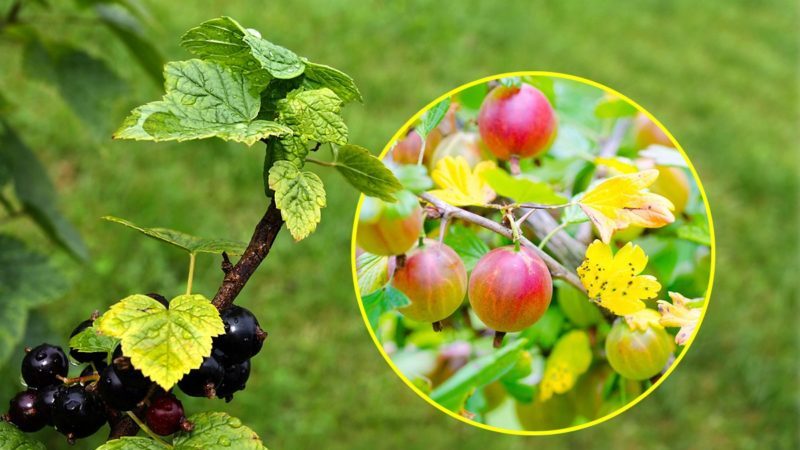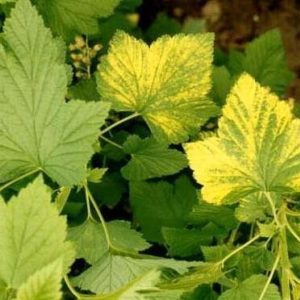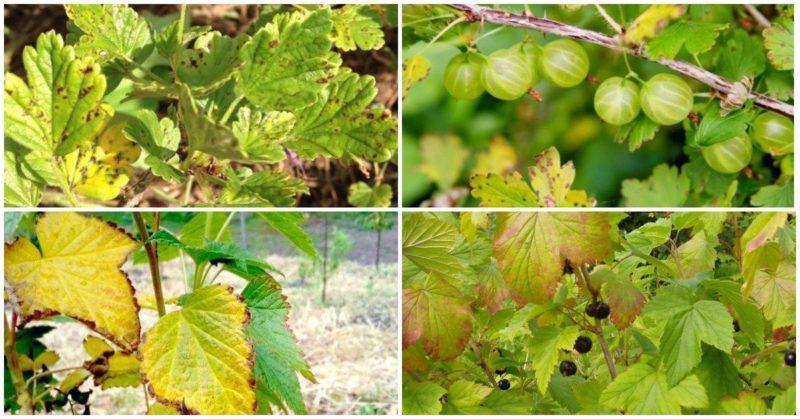Currant leaves turn yellow in June: why this happens and what to do in this case
One of the hallmarks of a healthy plant is its bright and rich leaves. A change in shade and deformation of the leaf plate indicate improper care, but more often it is a sign of disease or pest activity.
We will tell you why the leaves turn yellow currants in June and what to do in this case - use chemicals right away or do with folk methods.
The content of the article
Yellowing of leaves during drought in June
Early yellowing of leaves can be attributed to many factors. One of them is weather and climatic conditions (sharp temperature jumps, prolonged precipitation, etc.).
We will tell you in detail about other reasons - those that the gardener is able to eliminate on his own.
Deficiency or excess of nutrients
Currants turn yellow and dry often due to incorrect dressing. Deficiency or excess of a particular element is determined by external changes in foliage:
- Magnesium. The yellowing of the leaves in the lower part of the shrub indicates a lack of magnesium. In this case, the veins remain green, and the leaf blade turns yellow. You can fix the problem by feeding the plant with dolomite flour, wood ash or magnesium sulfate.
- Potassium. Potassium deficiency manifests itself in yellowing of the leaves along the edges, while the plate and vein remain green. It is possible to compensate for the deficiency of a substance with the help of potassium sulfate, potassium chloride or potassium magnesium. If the leaf curls down, but does not fall off, this indicates an excess of the mineral.
- Nitrogen. With a lack of nitrogen, the shoots stretch out, become thin, and fall off prematurely. The leaf plate loses color, only the veins remain green. Eliminates the problem of introducing mineral (urea, calcium nitrate, dolomite flour + ammonium nitrate) or organic (bird droppings, pig / horse / cow manure) forms of nitrogen. With an excess of the mineral, the leaves become brittle, saturated green.
- Iron. With an insufficient amount of iron in the soil, the leaf plate begins to turn yellow, and its edges dry out. Replenish the deficiency of the element by introducing ferrous sulfate under the root and ferrous chelate as a foliar feeding. The excess of the element is determined by sluggish leaves with light veins.
The rate of potassium per year for young bushes is 30 g, phosphorus - 40 g.
Lean or excessive watering
Lack of moisture, like its excess, is dangerous for the plant. With prolonged drought and insufficient watering, the plant signals a lack of water with yellow leaves.
But in conditions of constant humidity, the root system begins to rot. Therefore, it is important to comply with watering rates. Depending on the climate, 1-2 buckets of settled water are required for each bush. This amount is enough to moisten the soil by 40-60 cm and avoid rotting of the root system. Watering frequency - 2 times a month.
Lack of loosening and improper fit

In order for the soil to be moistened at the required level, the soil is maintained in a loose state without a surface crust. To do this, once every 15-20 days, the soil is loosened. Next to the bushes, this is done no deeper than 8 cm, and in the aisles - to a depth of 12 cm.
There is a close relationship between the growth of the root system and the development of the deciduous apparatus of the aboveground part of the plant. Therefore, the health of the plant depends on the depth of soil cultivation and the time of planting seedlings. If the seedlings are planted before the return frost, during the growing season, young plants will have yellow foliage, and the chances of survival of the bushes will be small. For better rooting, currants are planted in the fall, and for the winter they are insulated with burlap or spunbond.
The full development of the roots is hampered by a shallow planting pit. To avoid the problem, you need to deepen it.
For reference. The bushes can turn yellow due to old age - over the age of 15 years.
Plant pests and diseases
If the above reasons for the yellowing of currant leaves are easy to eliminate, then upon detection diseases or pests it will take more effort.
Yellowing of currant leaves among the symptoms of such diseases:
- Rust. The disease manifests itself in the form of yellow-orange warts on the lower part of the leaf or small red spots. Over time, the leaves and berries dry out and fall off.

- Anthracnose. On both sides of the leaf, circular brown spots are visualized, which eventually merge into yellow. Uncharacteristic foliage color indicates the final stage of the disease.
- Mosaic. The appearance of pale yellow spots indicates the initial stage of a viral disease. Over time, the leaf turns completely yellow, the affected tissue between the veins turns white and dries out.
- Verticillosis. Weak growth of shrubs and yellowing of leaves, their shedding from the lower tier indicates a lack of nutrients, since verticillary wilting affects the root and vascular systems of the plant.
Some yellowing of the leaves may cause powdery mildew, or spherotek.
It is recommended to promptly remove yellowed leaves, dig out and burn heavily damaged plants, use the fungicides Fitosporin-M or Agrolekar for treatment.
How to deal with pests
The appearance of harmful insects on the plant is also accompanied by yellowing of the leaves. Moreover, this is not the only symptom - depending on the pest, the signs differ.
It is not difficult to determine the activity of insects; it is enough to carefully examine the bushes. The peak of the infestation of pests occurs at the time of flowering and fruit formation.
Gall aphid
Aphids spoil currant leaves until mid-July, after which they move to other plants. In autumn, the insect lays eggs on the branches, where they winter safely and give larvae in early spring.
The presence of aphids is determined by brown and yellow bumps on the top of the leaf plate. Over time, the bumps darken, and the leaves dry out. If you look closely, you can see small, almost transparent insects in the affected areas.
It is important to notice any changes in the plant's leaf mass in a timely manner. At the first foci of deformation, the bush is doused with water brought to a boil. Most gardeners use this method even before the leaves appear to destroy the eggs of insects.
With a small lesion of the leaves (4-5 pcs.), They are torn off and burned outside the site. If damage is noticed on one branch, and tubercles are swollen on most of the leaf plates, then the branch is cut off, and the cut is treated with paint or garden varnish.
For reference... Gall aphids damage black currants to a lesser extent. Insects prefer colored varieties, since their leaves are thinner, and it is easier for the pest to pierce them and extract sap.
Folk ways
The most common way is to treat plants with boiling water. After the water boils, it is poured into a watering can with a diffuser and the bushes are poured over. After dousing, the trunks are treated with lime - this will continue the destruction of aphid eggs.
Other folk remedies:
- Baking soda solution. To prepare the solution, prepare a soap base: rub the laundry soap on a grater at the rate of 40 g per 10 liters of water.Sodium bicarbonate (2 tablespoons per 1 liter) is added to a warm soapy solution. The plant is treated in early spring, before bud break.
- Laundry soap. The tool is used if aphids have just appeared on the bushes. Rub 1.5 pieces of laundry soap on a grater and dissolve in 2 liters of warm water. To the resulting concentrate add 8 liters of water. Strain before use and spray.
- Celandine decoction... 4 kg of crushed celandine are poured into 10 liters of water and allowed to brew for 4-5 hours. The liquid will turn dark brown. Strain and start processing shrubs.
Use of biologics
Pests are fought in large quantities with insecticides and biological products. The latter do not harm the plant and are safe for human health, therefore they are actively used during the fruiting period. The most effective biological products:
- "Aktofit". Pests die 3-8 days after treatment. Consumption rate: 2 ml per 1 liter of water. The required dose is poured into 0.5 l of water, stirring constantly. The resulting mother liquor is poured into a sprayer tank filled with на while stirring. Then it is closed, shaken vigorously 2-3 times and immediately proceed to processing.
- Fitoverm. The death of insects occurs 2-3 days after the primary treatment of the plant. It is used as soon as pests appear during the growing season. 2-3 treatments are enough with an interval of 5-7 days. Consumption of the preparation: 2 ml per 1 liter of water.
Application of chemicals
The drugs do not work immediately, the aphid dies over time. After rains, re-treatment is required. The berries are harvested 5 days after the last spraying.
Chemicals are used as a last resort when aphids attacked in large numbers and other methods did not work. Among modern insecticides, gardeners distinguish the following:
- Actellik. A product with a high rate of destruction and suppression of pests. Dosage: 1.5-2 ml per 1 liter of water. Enough double treatment with an interval of 5-7 days. Compatible with biologics.
- Biotlin. An analogue of Aktellik, but more affordable. The manufacturer guarantees the death of pests in 3-4 hours. The working solution is prepared by diluting the concentrate first in a small amount of water (0.5-1 l), and then adding water to the required amount. Consumption rate depending on the size of the bush: from 0.5 to 1.5 liters per bush.
When spraying with chemicals, use protective clothing, mask and gloves. Do not use during fruiting. Harvesting begins no earlier than 20-30 days after the last treatment.

Glass-maker
These are caterpillars of whitish color with a black head.... They appear at the end of June and immediately try to get inside the shoots. The pest prefers young bushes, mainly black currant. It is rarely seen in other species. Caterpillars move along the entire shoot down to the root, gnawing out the core and leaving a hollow place. If you make a longitudinal cut in a branch, you can notice a move with excrement or the caterpillar itself.
Damaged shoots stop growing, dry out and break off. There are very few berries, they taste sour. The caterpillar hibernates in the branches themselves, therefore, in order to prevent the life cycle of the pest in its area, a set of measures is taken.
If a pest is found, cut and destroy all dry shoots. Pruning carried out throughout the growing season.
In early June and throughout the growing season, they fight against adults - butterflies. After a decrease in their number, the number of larvae also decreases. Prevention is carried out with biological insecticides "Fitoverm Forte", "Bitoxibacillin". Plants and root area are treated with an interval of 7-8 days.
For reference. Butterflies appear in the second half of June. In order not to miss the moment, traps with sweet syrup or fermented jam are placed near the currants. The processing of plants is started as soon as at least one of the adults falls into the trap.
Chemicals
Biological insecticides are only good for prevention. Only chemical preparations will help in the fight against pests. When the buds begin to open, the bushes are treated with Karbofos. Also, before flowering currants use "Inta Vir". Procedure:
- "Karbofos". A 10% solution of the drug is suitable for eliminating the glass case. Use a suspension or water-soluble powder. When processing berry crops, irrigation is often used. The first treatment is carried out in early spring, the second after flowering. Consumption rate: 30 g for 4 liters of water. One bush is enough for 1-2 liters.
- "Inta Vir"... Available in tablets. 1 tablet is enough for 10 liters of warm water. First, a mother liquor is prepared: the crushed tablet is diluted in 300 g of water, then another 700 g is added and stirred. After that, the water is added to the norm, shaken and irrigated.
In parallel with currants, raspberry bushes are also processed, since adults prefer the pollen of this berry culture.
If the complex measures are not successful, the damaged bush is cut to the root and burned.
Traditional methods
These methods are more aimed at scaring off adults. It is useless to use any available means to deal with the glass.
To scare off, moisten small pieces of rags in gasoline and hang them on the bushes. The pungent smell overpowers the smell of currants, and butterflies cannot detect it. Also used in the form of bait, cardboard boxes of red or yellow color, under them put cans of molasses. Bright colors attract butterflies, but they cannot cling to cardboard and fall into cans of sticky substance.
Spider mite
The appearance of a thin gray spider web, yellowing and wilting of leaves, and weakening of the growth of bushes are signs of a spider mite invasion. Due to its small size, this dangerous pest is difficult to notice in time. The lesion usually starts from the lower leaves of the plant, then spreads upward. The oldest leaves are examined for spotting, and larvae and adult ticks are looked for on their underside.
Timely detection of ticks is crucial for reducing the pest population and further effective treatment. The period of active breeding falls on the second half of spring.
Chemicals
The spider mite belongs to the class of arachnids, not insects, as is commonly believed. Therefore, using insecticides in the fight against the pest is a mistake. Acaricides and insectoacaricides have a detrimental effect on ticks. Usually, two treatments per season are sufficient, excluding the time of flowering currants.
Attention! Chemical treatment is carried out in dry and calm weather, using protective clothing and a mask.
Effective drugs:
- «STOP tick ". The agent acts at all stages of insect development, destroying them already in the first minutes after treatment. Also, the drug has a long period of protective action and does not affect the growth and development of plants. Consumption rate: 7 ml for 5-6 liters of water.

- "Envidor". The action is directed at all stages of pest development. Due to its high adhesion, the drug can be used in rainy weather. Consumption rate: 2-3 ml per 5 liters of water. It is used on fruit and berry bushes twice a season, no later than 20 days before harvest.
- Sunmight. It is effective not only against ticks, but also against other insects. The most successful time for processing is the period of active flowering. Possesses absorbency, therefore does not require re-processing after precipitation. To eliminate the resistance of pests to the active substance, one treatment is done per season. Consumption rate: 5 g per 5 liters of water.
Biological preparations
Biological products are also effective. For targeted control of ticks, the following are used:
- "Bitoxibacillin". Most effective at the larval stage of pests. Powder consumption rate: 80-100 g per 10 liters of water.The last irrigation is 5 days before harvest.
- Fitoseyulus. A preparation containing live predatory mites that eat spider webs. With a rapidly growing population of the pest, 20-50 individuals of predatory mites are evicted per 1 m² every 14 days. After the destruction of spider mites, the bio predator dies.
Folk remedies
The struggle with folk remedies is reduced to spraying currants with caustic compounds with a deterrent smell:
- Garlic extract. Chop 5 cloves of garlic, pour 1 liter of cold water and leave for 10-12 hours until air bubbles appear. Then it is filtered, the extract is diluted in an equal ratio with water and carefully sprayed onto the bushes. Repeated procedure - in 20-21 days.
- Tobacco infusion. 250 g of dry leaves, dust or crumbs are poured over 2.5 liters of hot water and infused throughout the day. Filter, add another 0.5 l of water and 20 g of crushed laundry soap for better adhesion of the product to the leaves.
- Herbal infusion. Prepared from calendula, wormwood, celandine. For 10 liters of hot water, take 100-120 g of herbal raw materials to choose from and let it brew for 2-3 hours. Strain before irrigation.
To suppress the vital activity of ticks and prevent their development, colloidal sulfur or water-alcohol infusion is also used.
Prevention measures
Preventive procedures are carried out in the fall so that pests have no chance to lay eggs:
- If the bush is affected by pests, additional insecticide treatment is carried out in the fall. Preventive spraying is possible in the spring before bud break.
- Sanitary and regulatory trims are mandatory. All branches that thicken the bush are subject to removal. Sick, dried, weak stems must be cut off. After the procedure, the slices are smeared with garden pitch - this reduces the likelihood of penetration of harmful microorganisms into the stems.
- After leaf fall, the crown is watered abundantly, the near-trunk circle is carefully loosened so as not to hurt the surface roots. Sprinkle with wood ash, mustard or ground pepper.
- All yellowed leaves are collected and burned.
- Strong-smelling plants - garlic, onions, calendula - are planted not far from the bush.
To exclude the penetration of larvae into the bark, all care work is carried out as carefully as possible so as not to damage it.
Conclusion
Pests often appear at the beginning of the growing season, but gardeners notice their presence when the plant leaves turn yellow and wither. Careful inspection of shrubs allows you to prevent the reproduction of pests and take timely measures to preserve the crop. In most cases, biological preparations that are non-toxic and safe for humans can be dispensed with.